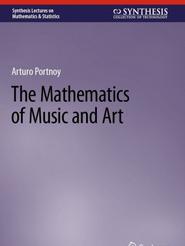The Mathematics of Music and Art
Soft / Music Magazines
1-08-2023

This book explores the relationships between music, the sciences, and mathematics, both ancient and modern, with a focus on the big picture for a general audience as opposed to delving into very technical details.
The language of music is deciphered through the language of mathematics. Readers are shown how apparently unrelated areas of knowledge complement each other and in fact propel each other’s advancement. The presentation as well as the collection of topics covered throughout is unique and serves to encourage exploration and also, very concretely, illustrates the cross- and multidisciplinary nature of knowledge. Inspired by an introductory, multidisciplinary course, the author explores the relationships between the arts, sciences, and mathematics in the realm of music. The book has no prerequisites; rather it aims to give a broad overview and achieve the integration of the three presented themes. Mathematical tools are introduced and used to explain various aspects of music theory, and the author illustrates how, without mathematics, music could not have been developed.
home page:
https://goo.su/5TR5z
The language of music is deciphered through the language of mathematics. Readers are shown how apparently unrelated areas of knowledge complement each other and in fact propel each other’s advancement. The presentation as well as the collection of topics covered throughout is unique and serves to encourage exploration and also, very concretely, illustrates the cross- and multidisciplinary nature of knowledge. Inspired by an introductory, multidisciplinary course, the author explores the relationships between the arts, sciences, and mathematics in the realm of music. The book has no prerequisites; rather it aims to give a broad overview and achieve the integration of the three presented themes. Mathematical tools are introduced and used to explain various aspects of music theory, and the author illustrates how, without mathematics, music could not have been developed.
home page:
https://goo.su/5TR5z
Related articles
Soft / Music Magazines
30-06-2022
This book constitutes the thoroughly refereed proceedings of the 8th International Conference on Mathematics and Computation in Music, MCM 2022, held in Atlanta, GA, USA, in June 2022.
The 29 full papers and 8 short papers presented were carefully reviewed and selected from 45 submissions.
Soft / Music Magazines
25-04-2022
This book presents a new semiotic theory based upon category theory and applying to a classification of creativity in music and mathematics. It is the first functorial approach to mathematical semiotics that can be applied to AI implementations for creativity by using topos theory and its applications to music theory.
Of particular interest is the generalized Yoneda embedding in the bidual of the category of categories (Lawvere) - parametrizing semiotic units - enabling a Čech cohomology of manifolds of semiotic entities. It opens up a conceptual mathematics as initiated by Grothendieck and Galois and allows a precise description of musical and mathematical creativity, including a classification thereof in three types. This approach is new, as it connects topos theory, semiotics, creativity theory, and AI objectives for a missing link to HI (Human Intelligence).
Soft / Music Magazines
8-02-2022
Professor Michael Edgeworth McIntyre is an eminent scientist who has also had a part-time career as a musician. From a lifetime's thinking, he offers this extraordinary synthesis exposing the deepest connections between science, music, and mathematics, while avoiding equations and technical jargon. He begins with perception psychology and the dichotomization instinct and then takes us through biological evolution, human language, and acausality illusions all the way to the climate crisis and the weaponization of the social media, and beyond that into the deepest parts of theoretical physics - demonstrating our unconscious mathematical abilities.He also has an important message of hope for the future.
Soft / Music Magazines
1-02-2022
Mathematical Music offers a concise and easily accessible history of how mathematics was used to create music. The story presented in this short, engaging volume ranges from ratios in antiquity to random combinations in the 17th century, 20th-century statistics, and contemporary artificial intelligence.
This book provides a fascinating panorama of the gradual mechanization of thought processes involved in the creation of music. How did Baroque authors envision a composition system based on combinatorics? What was it like to create musical algorithms at the beginning of the 20th century, before the computer became a reality?